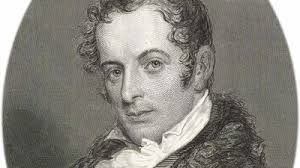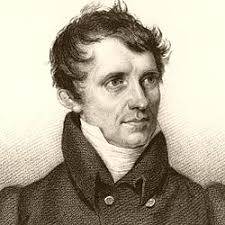3-The Rise of American National Literature
2. Prominent Authors and Works
·
Knickerbocker Era 1810-1840
In the
early 19th century, New York was the center of American writing. The writers
are known as “Knickerbockers”. The name comes from a History of New York, by
Diedrich Knickerbocker by Irving Washington. It is a humorous book about the
local history of the city. He laughs at the Puritans and Dutch governors. He
invented many events and legends. His aim is to give New York a special local
color.
·
Irving Washington

Born in 1783 in New York City, Washington
Irving came from a Scottish-English family and according to Edwin W. Bowen,
‘’Washington Irving [was] properly accorded the first place among the pioneers
in American literature’’. He moved to England in 1815; however, after the
company that he worked became bankrupt, he turned his attention into writing.
He was a great observer of European literature. He borrowed the origin of Rip
Van Winkle from a German folk tale titled "Karl Katz." and published
it in 1819. The reason for borrowing was the lack of specific American themes
and issues at the time. However, Washington Irving strewed American features
into Rip Van Winkle. He became the first person to use the short story form of
fiction and gained international respect for American Literature, noted for his
contributions to a burgeoning national literature. According to Fiedler, Rip “presides over the birth of the American
imagination” (6). In addition, he is “[t]he guardian angel and symbol of the mythic American” (Leary
22-23)
The Sketch Book contains two small
masterpieces that initiated the great tradition of the American short story,
“Rip Van Winkle” and “The Legend of Sleepy Hollow.” Four other sketches are
also set in America, but most of the other pieces are descriptive and thoughtful
essays on England, where Irving was still living. It contains 32 stories. The majority are on
European subjects, mostly English. For Washington Irving, “We are young people
and must take our examples and models from the existing nations of Europe”
(High 31)
Both “Rip Van Winkle” and “Sleepy Hollow”
have origins in German folklore, but Irving fills them with the local color of
New York’s Hudson River Valley. Irving
admits as much in a “Note” to the first tale. Both also owe a debt, in terms of
stylistic influence, to Sir Walter Scott. Nevertheless, both exploit their
specifically American settings and create American myths: they explore the
social and cultural transformations occurring in America.
In his best work, Irving was a creator of
significant American myths: narratives that gave dramatic substance to the
radical changes of the time, and the nervousness and nostalgia those changes
often engendered. Perhaps he was so effective in fashioning those myths because
the nervousness about the new America, and nostalgia for the old and, beyond
that, for Europe- were something that he himself felt intensely. He was writing
himself, and the feelings he typified, into legend.
His literary works include Bracebridge Hall,
Tales of a Traveler, The Alhambra, The Life and Voyages of Christopher Columbus
and The Conquest of Granada. Irving was the first to earn his living through
literature.
Another Knickerbocker writer, James Kirke
Paulding, contributed to early American literature with works like The
Dutchman’s Fireside, an amusing satire set in colonial America. His writing
reflects anti-Indigenous views and support for slavery. Like other
Knickerbocker writers, Paulding did not attempt to represent the entire
American continent; instead, his focus remained firmly on New York and its
regional culture, reflecting the localized perspective common among this
literary group. (High 33)
·
James Fenimore Cooper

In his works, he spoke for all of America.
He celebrated the best qualities of the American personality while also
offering harsh criticism of its injustices and shortcomings.
In Europe, he gained recognition as “The
American Walter Scott” for his contributions to historical fiction. His
characters were not just regional figures like “New Yorkers,” but true
representations of the broader American experience.
He is credited as the founding father of
the American historical novel, using the genre to explore the deep conflicts
and changes taking place in American society during a transformative era. In
addition, he helped develop and popularize multiple literary forms, including
the sea novel, the novel of manners, political satire and allegory, and the
dynastic novel, which examined American principles and social practices across
generations.
His major works are:
- Precaution (1820) was in fact written after his wife challenged his
claim that he could write a better book than the English novel he was reading
to her. A conventional novel of manners set in genteel English society.
- The Spy: A Tale of the Neutral Ground (1821) a man who moves back and
forth between American and British Camps during the Revolution.
- The Pioneers: the first novel of Cooper’s “Leatherstocking” series.
The main character is Natty Bumppo, known here as
Leatherstocking. He is a typical American pioneer figure. His sympathy for all
people, including the Indians is unusual. (Chingachgook, the friend and comrade
of Natty)
-The Last of the Mohicans (1826) presents Bumppo,
here called Hawkeye, in his maturity and is set in 1757 during the Seven Years’
War between the French and the British.
-In The Prairie (1827), Bumppo, known simply as the
trapper, has joined the westward movement; he is now in his eighties and, at
the end of the novel, he dies.
-The Pathfinder Here, Bumppo is tempted to think of
marriage. But, when he learns that the woman in question loves another, he
nobly accepts that he cannot have her. Like the many Western heroes for which
he was later to serve as prototype, he recognizes that, as he puts it, it is
not according to his “gifts” to love and to marry.
-The Deerslayer: Natty in his twenties.
James Fenimore Cooper describes the
triumph of time and civilization over the wilderness, portraying the gradual
transformation of the untamed American landscape into a more settled and
structured society. This theme is central in many works, reflecting the
nation's broader expansion and development.
Cooper excels in writing scenes filled
with violent action, terror, and mystery, bringing intensity and drama to his
narratives. These elements contribute to the lasting appeal of his adventure
and historical novels. However, his depictions of women characters are often
considered weak. They tend to lack depth and complexity compared to his male
protagonists (High 37-38).
·
The Poet William Cullen
Bryant
He dislikes neoclassical style, which
emphasized rigid forms, imitation of classical models, and restrained emotion.
Instead, he aligned himself with the ideals of the Romantic poets of Europe,
particularly Wordsworth, who championed a more natural, emotional approach to
poetry. He believed that new poetry should not merely imitate the forms of
ancient classics, but should instead strive to connect with the reader’s
emotions and offer a deeper understanding of the world. For him, “the great
spring of poetry is emotion”. In this regard, true poetic expression arises
from genuine feeling rather than strict adherence to traditional form (High
39).

